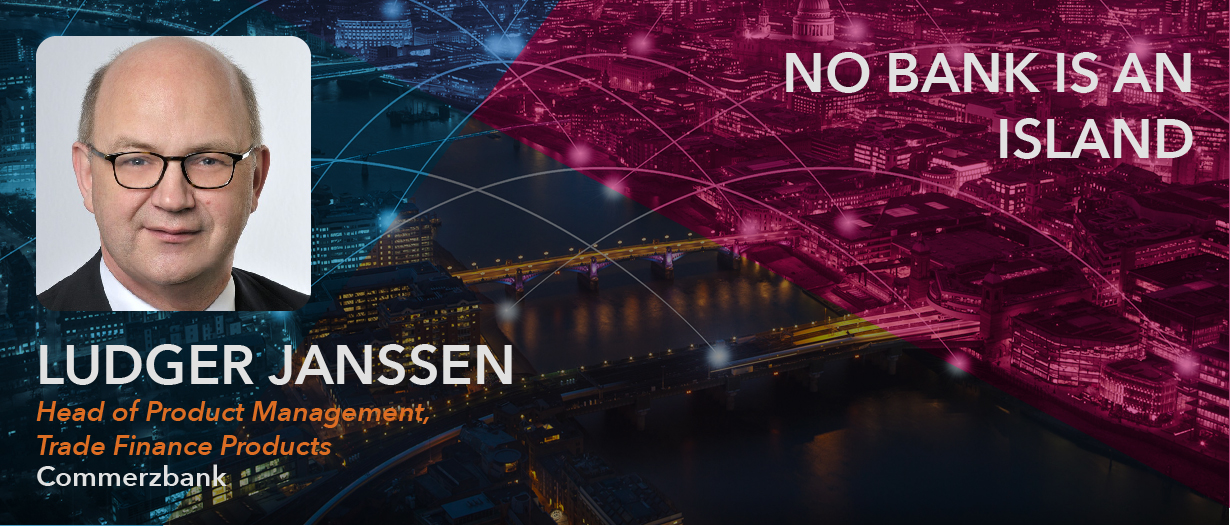To advance trade finance’s digital transformation, financial institutions and technology providers alike are ramping up efforts to cooperate through a number of consortiums. But, to ensure these various initiatives do not create a cluster of “digital islands”, a more joined-up approach is required.
The importance of digitalising trade finance should not be under-estimated. One German corporate recently told me it’s spending millions of euros each year in demurrage costs while cargo sits idly in terminals as it waits for processing, customs clearance, bank handling, dispatch or delivery of its accompanying documents. The result is clear: higher transaction costs and unnecessary barriers to trade, which places strain on global commerce.

Is digitalisation part of the solution? There are indeed many industry initiatives underway, all working to make trade finance faster and more connected. Yet this welcome development also bears the risk of further fragmentation, hindering progress. Therefore, the financial community – as well as governments and international trade bodies – should look to a common objective: to prevent an archipelago of “digital islands” forming. This, we believe, requires the establishment and revision of industry rules and standards.
The importance of standards
Commerzbank recently hosted a workshop for trade participants from the corporate, bank, fintech and insurance world, which concluded that full migration of trade finance transactions from paper to digital processing was vital to reducing the operational (and cost) burdens experienced by corporates.
But this hinges on establishing industry-recognised standards – especially since a given trade finance transaction could easily involve 20 or more parties such as banks, shippers, insurers, agents and custom authorities – to govern the process of sharing trade data digitally.
Digitising Trade Documents: Bill of Lading, Certificates of Origin
The benefits for all parties could be enormous. We note that corporates are already demanding the option to view invoices within their enterprise resource planning (ERP) systems, which their bank can then extract for financing. We can also anticipate a future in which a digitalised Bill of Lading is transferred and processed without delay between customs authorities, banks and shippers, or in which Certificates of Origin can be easily shared and verified thanks provided they agree with the standards set.
Yet establishing a common language is easier said than done. Terms like “digitalisation” are often conflated with “electronification” (which simply means transferring paper documents onto digital platforms).
Electronification, however, is merely the first step. Digitalisation, in its truest sense, should mean that all trade transaction information (bills of lading, certificates of origin, letters of credit) would be written in a universal binary code language, which any computer can process and present for each party’s consumption. No paper necessary.
Yet the difficulty in establishing standards for trade finance’s digital future goes even beyond the digital transfer of data as such because rules and standards are also needed for such far-reaching aspects of our international business. For instance, to recognise the complexities of creating a global standard, one only needs to consider the legal considerations in trade transactions, the local habits and region-specific rules, as well as the nuances that can arise in individual transactions.
Cooperation: the vital ingredient
Establishing rules and standards therefore represents a mountain to climb, but the rewards are high and cooperation will be key if we want to benefit from the trade finance consortiums, industry initiatives and individual innovations that have emerged over the last years.
Without standardisation, the lack of coordination between these initiatives could be confusing matters unnecessarily. Rather than establishing a standard, the end-result could be a cluster of disparate “digital islands”, unable to communicate – let alone integrate – without significant investment. So, what can be done to avoid fragmentation? Simply, the multitude of systems available can only become interoperable by establishing a means through which the various platforms can communicate.
Understanding the potential of standardisation, the industry is cooperating more closely. One such initiative is the Universal Trade Network (UTN), whose members include the banks and blockchain companies participating in the Marco Polo blockchain project, as well as fintechs and industry partners. To avoid being yet another “island”, the group’s objective is to be technology-agnostic, focused wholly on improving interoperability between not only blockchain solutions but also other technologies within the trade finance ecosystem.
Objective number one for the UTN, of which Commerzbank is a member, is to create bridges able to connect the cluster of blockchain networks that have emerged – thus creating a “network of networks”. From there, the group can begin to drive standards across trade finance that transcend the individual platform or service being used. Think of it like being able to read an email from your client, even though she works on a different email domain and using a different web browser – something we perhaps think routine but was only first possible thanks to standardisation.
Wider buy-in is needed
Of course, faster progress in standardisation can only happen if there’s coordination within the financial community in cooperation with governments and international bodies. In July, the International Chamber of Commerce (ICC) Banking Commission’s new e-rules for the presentation of electronic documents under Letters of Credit, the so-called eUCPs, came into effect. The body also established for the first time electronic Uniform Rules for Collections (eURC), while the formation of a working group for digital trade rules should help to advise trade consortiums on how to execute financial obligations in accordance with their own processes.
What has been clear from the financial community’s efforts to digitalise trade finance, to date, is that financial institutions and technology companies cannot act alone. One difficulty is that trade finance digitalisation isn’t high on the political agenda. Highlighting how easing trade finance processing could boost productivity and international competitiveness will be one way to pique the attention of politicians and industry bodies alike.

































